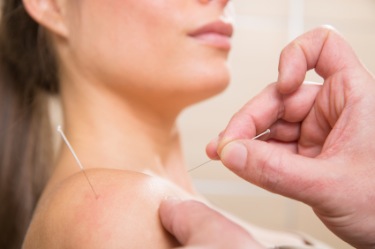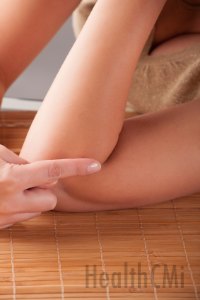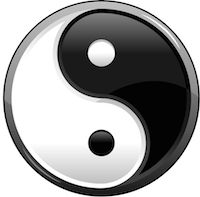New research conducted at the department of surgery at the Bnai-Zion Medical Center, Israel finds acupuncture effective in reducing pain after shoulder surgery. Individualized acupuncture treatments according to Traditional Chinese Medicine (TCM) principles were applied to patients with intractable pain following laparoscopic shoulder surgery. The researchers concluded that acupuncture is both effective and safe; no significant side-effects occurred. 
The focus of the study was the integration of acupuncture into conventional post-surgical pain intervention protocols. Acupuncture point prescriptions were individualized for each patient according to TCM differential diagnostics. The researchers note that the conditions treated were complex “due to the physiological and biochemical effects of surgery and medications.” The investigators note that pre-surgical disharmonies and “acute manifestations that were a consequence of the surgery” were often difficult to differentiate within TCM diagnostics. As a result, patients were treated for both pre-surgical disharmonies and disorders caused by surgical intervention. This reflects a common approach taken by most licensed acupuncturists in a standard clinical setting.
The researchers tackled several major issues associated with integrating acupuncture into the conventional surgical setting. They differentiated between acupuncture and other pain reduction interventions by comparing patients taking analgesic medications and patients receiving only acupuncture treatments. They add that pragmatic trial methodologies such as this can be implemented to assess effectiveness.
Another topic addressed by the research team was whether or not individualized acupuncture point prescriptions or standardized, protocolized approaches are appropriate in “busy, high volume” surgical departments. The research team favored individualized acupuncture point prescriptions based on differential diagnostics over a single point prescription. They note that future investigation is required to determine if their approach produces the most positive patient outcomes, easiest administrative integration and most efficient cost-benefit outcomes. The team notes, “The novelty of our study is in the application of classical TCM approaches to modern acute hospital care.”
Patients met inclusion criteria for the study if analgesic medications failed to control pain from post-laparoscopic shoulder surgery. Patients were then categorized according to TCM clinical patterns and syndrome differentiation. Physical examinations including traditional facial, voice, tongue and pulse diagnoses were performed. Two acupuncturists were required to validate diagnoses for each patient and an additional acupuncturist was assigned to follow-up on patient care from initial care to resolution. Customized treatment plans were employed for all patients.
Disposable single-use acupuncture needles (Dongbang Acupuncture Inc. brand) with spring handles were used. Needles were 20 X 30mm in length. Deqi sensations were elicited at acupuncture points and needle stimulation techniques were employed using TCM principles. Dispersing needling was retained for 30 minutes, balancing needling was retained for 20 minutes and tonifying needling was retained for 15-18 minutes. The total number of needles ranged from 4-8 per treatment session. 
Measurements revealed a direct relationship between focal, highly localized pain reduction and general body pain reduction. A linear correlation was discovered. Patients experiencing less shoulder pain as a result of acupuncture also had a corresponding decrease in pain throughout the entire body.
A total of 5 TCM related syndromes were the main diagnoses associated with post-laparoscopic shoulder pain: phlegm, heat, qi and blood stasis, dampness, qi and blood deficiency. Acupuncture point PC5 was applied to all cases of phlegm. A total of 1-2 additional points were selected for phlegm from the following selection: ST40, TB10, LV2, GB40. The point selection was based on differential diagnostics.
Heat syndrome was treated from the following selection: LI11, ST40, LV2, GB40, SP6, KI2. Qi and blood stasis was treated from the following: LI4, LV3, PC6, PC7, SP10. Dampness points were selected from: LU5, SP9, SP6, SP3. Qi and blood deficiency acupuncture points included: ST36, ST37, ST38, ST39, SP6, LV3, LV4, SP10.
TCM phlegm patterns are classically associated with emotional trauma. The researchers detail this process. Surgery involves emotional issues including familial relations and fear of death while emotional and spiritual sensitivities are heightened. The study documents that TCM theory indicates that excess of any of the 5 emotions (i.e., fear/fright, joy, worry/doubt, sadness, anger) leads to excess qi buildup that transforms into “fire” and condenses into body fluids and consequent phlegm. The research notes that anxiety and fright are most common in pre-surgical settings.
The research notes that Gong Ju Zhong, a renown TCM scholar, once said, “Phlegm is produced by fright. The Shen (spirit) leaves its residence, and when the residence is empty, the fluids will form phlegm.” This creates a process wherein phlegm blocks the free flow of qi thereby creating qi stagnation related pain. The team chose two treatment principles to treat this syndrome: dispel and disperse phlegm, stop current and future phlegm formations. Interestingly, acupuncture points used to disperse phlegm caused a sense of “emotional relief” followed by pain reduction.
Qi and blood stasis presented in classical form (i.e., sharp, severe pain). A purple color on the tongue was also included as a diagnostic sign for this pattern. The team notes that this type of stasis is created by either surgery related emotional stress or “the mechanics of the surgical procedure….” Tongue, pulse and facial diagnostic procedures were used to determine heat patterns. The staff reported that patients treated for heat became “more compliant and easier to deal with.”
Dampness was diagnosed based on pulse and tongue diagnoses, the presence of obesity and a subjective feeling of heaviness. A swollen tongue with a yellow or white coating indicated dampness and the thickness of the tongue coating indicated the severity of dampness. The staff noted that dampness pattern patients are less likely to “get up and move around” thereby potentially impairing recovery. A goal was to facilitate rehabilitation by enhancing mobilization.
Deficiency pattern patients were characterized by appearing less vital, having less overall energy and presenting with corresponding tongue and pulse diagnosis signs. Spleen qi deficiency was the most common form of deficiency. Yin deficiency of the kidney and stomach was in several patients and lung qi deficiency was present in one patient. 
The team formulated customized point prescriptions based on differential diagnostics and noted that other research more often employs fixed formula approaches according to a specific disease. Patients were only entered into the study by nurse and doctor referral if medications failed to control the pain. In this regard, acupuncture’s ability to reduce pain is judged through the lens of a sample size consisting of severe, persistent and intractable pain.
Being a surgery department, the research team took a very pragmatic and humanitarian approach. They noted, “We are less interested in whether complementary medicine can, or should, replace other forms of conventional pain management, but rather whether it can be used safely and effectively to complement current conventional pain management approaches.” The data tabulated and analysed, acupuncture demonstrated significant reductions in both local and whole body pain. The flow of patient care integrated smoothly into the current system of administration and no adverse events were reported. As a result, the team suggests that additional acupuncture continuing education is advisable including more randomized, controlled trials.
For Licensed Acupuncturists
To receive a free eBook on acupuncture continuing education, acupuncture CEU and acupuncture PDA requirements, click the following to learn more: Free eBook.
Reference:
Kreindler, Gur, Samuel Attias, Anna Kreindler, Haim Hen, Bassel Haj, Ibrahim Matter, Eran Ben-Arye, and Elad Schiff. "Treating post-laparoscopic surgery shoulder pain with acupuncture."


